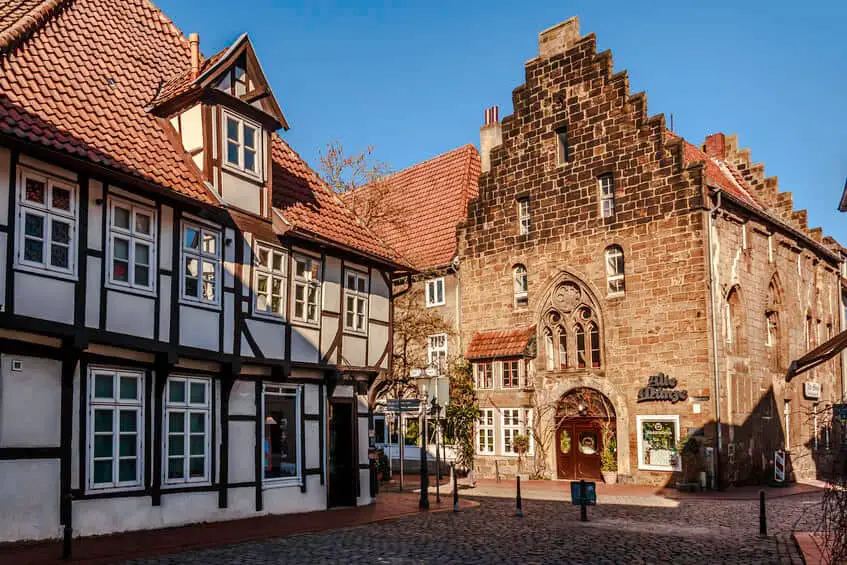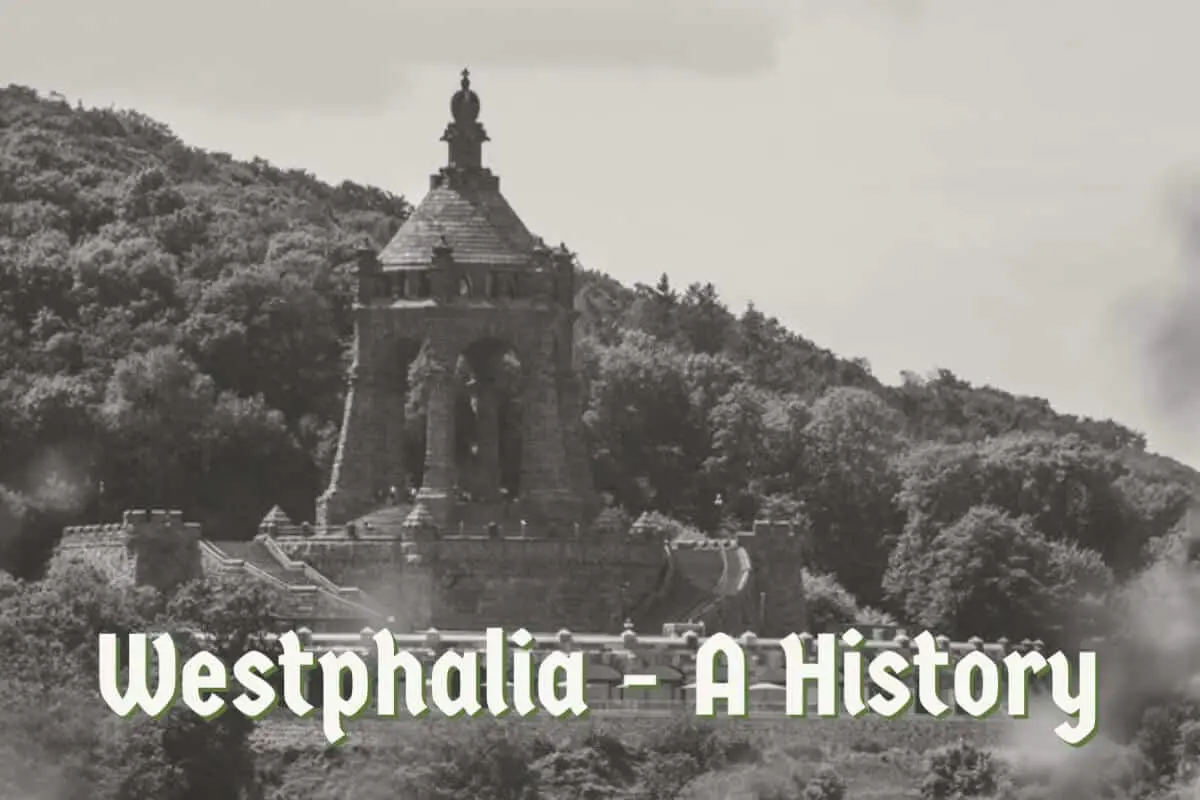I have great parents who came to the United States from the Minden area of Westphalia. Like many parts of present-day Germany, this area has a fascinating history.
Westphalia’s history goes back to the times of the ancient Saxons. For a period of time, Westphalia was under the rule of Napoleon and the French. Later Westphalia became a state of Prussia until it officially became part of Germany in 1945.
Table of Contents
- Westphalia’s Early History
- The Westphalia 1648 Peace Conference
- Kingdom of Westphalia (1807-1813)
- Province of Westphalia
- Related Questions
Westphalia’s Early History
Westphalia, also known as German Westphalia, is a region in northwestern Germany. It comprises a large part of the present German area of North-Rhine -Westphalia, Germany.
The ancient Saxons originally settled in the Westphalia area. The ancient Saxons were divided into three main groups 1) Westphalian 2) Angrians (German – Engerns) and 3) Eastphalians (Ostfalen).
The Westphalen’s settled about 700 AD in the areas of the Ems and Hunte rivers. By 775 they were as far down as Cologne, Germany.
For almost three centuries this region retain a separate identity; they were able to maintain this separate identity in spite of the rise of a powerful Saxon duchy. By the 12th century, all the area west of the Weser River was known as Westphalia.
In 1180, Cologne’s archbishops received Westphalia as a duchy; this new duchy was confined to an area northwest of Cologne. In 1512 the lower Rhine- Westphalia circle of the Holy Roman Empire was formed.

The Westphalia 1648 Peace Conference
From 1644 to 1648, the Westphalia towns of Münster and Osnabrück hosted a critical Peace conference that settled Europe’s 80 years of war and the German 30 years of war. It was this peace treaty that contributed to the foundation of the modern European nation-states.
A new concept of international sovereign law emerged from the Westphalia Peace Treaty. The Westphalia system or Treaty of Westphalia is defined as:
“A global system based on the principle of international law that each state has sovereignty over its territory and domestic affairs, to the exclusion of all external powers, on the principle of non-interference in another country’s domestic affairs, and that each state (no matter how large or small) is equal in international law. The doctrine is named after the Peace of Westphalia, signed in 1648, which ended the Thirty Years’ War.”
Boundless World History
Kingdom of Westphalia (1807-1813)
In the early 17th century, the Hohenzollern rulers of Brandenburg-Prussia gain some territories in Westphalia. In 1803 they acquired most of Paderborn and Münster.
By 1807 Napoleon had taken over Westphalia, and it became the Kingdom of Westphalia from 1807 to 1813. At the time, Westphalia had a population of about 2.6 million people.
Though the kingdom was independent of France, it was actually a state of the first French empire that Napoleon ruled. Napoleon wanted Westphalia for his brother Jerome Bonaparte to rule.
Napoleon imposed the first written modern constitution in Germany on Westphalia; the constitution liberated the serfs and gave everyone equal rights under the law. Everyone also had the right to a jury trial.
In 1808 the Kingdom passed Germany’s first laws allowing Jews equal rights under the law; this helped\ provide a model for reform for other German states. By all accounts, Westphalia was a progressive kingdom.
Westphalia was relatively poor, but this did not stop Napoleon from demanding heavy taxes and payments from the country. He also constricted soldiers to fight in his army; many never returned.
Here is a chart to show how the population and area of Westphalia changed from 1809 to 1812:
| Year | Square Kilometers | Square Miles | Populations |
| 1809 | 37,883 | 14,627 | 1,950,724 |
| 1810 | 63,652 | 63,652 | 2,612,000 |
| 1812 | 45,427 | 45,427 | 2,065,970 |
When you look at this chart you can see how under the Jerome Bonaparte and Napoleon lands of Westphalia were being conquered and then lost again.
By 1812 the Westphalia was bankrupt. When Napoleon was defeated, and in 1813 the kingdom was overrun; by 1815, most of the territory became under Prussia. Even though the Prussians had power over Westphalia, most of Napoleon’s reforms remained.
Province of Westphalia
Westphalia remained a province of the Kingdom of Prussia or the free state of Prussia from 1815 to 1946.
Here are some facts about Westphalia:
- The Free State of Prussia from 1815 to 1946
- The main religion in Westphalia was Roman Catholic.
- The common languages are German, French, and Low German.
- Congress of Vienna in 1815 gave Prussia the territory of Westphalia and created the Province of Westphalia.
- There was another region called the Duchy of Westphalia. This was annexed to Westphalia in 1816.
- In 1907 the economy of Westphalia was 18% agriculture, 59% industry, and 11% trade.
- Capital of Westphalia was Münster.
- In 1817 Westphalia consisted of 20,215 square kilometers or 7,805 square miles.
- In 1925 its population was recorded as just over 4,700,000
- After World War 2, the present state of North-Rhine- Westphalia (Nordrhein-Westfalen) was created by merging the former Prussian Province of Westphalia with the northern half of the former Prussian Rhine Province and the Province of Lippe.
Related Questions
What Was the Kingdom of Wurttemberg?
The Kingdom of Württemberg existed from 1805 to 1918. The Kingdom had four different Kings. Though the Kingdom of Württemberg is now part of present-day Germany, during its existence the alliances of the Kingdom changed. The last King of Württemberg was forced to abdicate in 1918.
You can read more by reading A History of The Kingdom of Württemberg – Germany by clicking here.
What is Primogeniture or the Law Of Succession?
Primogeniture is defined as the law or right for the firstborn legitimate son to inherit their parent’s entire estate such as land and houses. In the later part of the 18th century, many places in the world started to rebel against the restrictions of the primogeniture succession law. In Jane Austen’s novels, one of the major themes was the effect this law had on women having to “marry well” to survive.
You can learn more by reading What is Primogeniture or the Law Of Succession? by clicking here.
